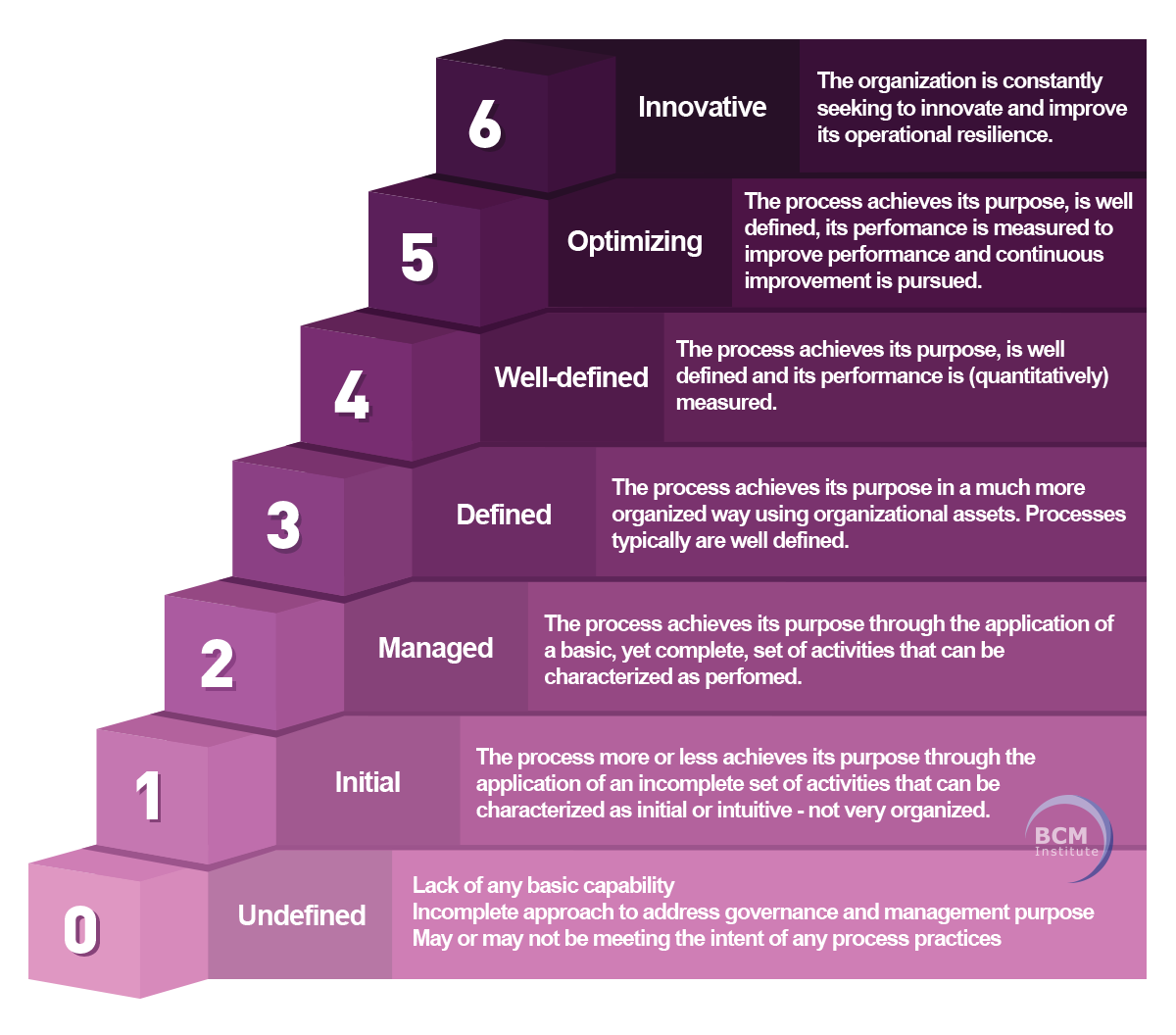
 Operational resilience is the ability of an organization to withstand and recover from operational disruptions, whether caused by internal or external events.
Operational resilience is the ability of an organization to withstand and recover from operational disruptions, whether caused by internal or external events.
Operational resilience involves identifying critical business services and ensuring they can continue operating during an operational disruption. It also involves developing plans to recover from the disruption and return to normal operations as quickly as possible.
| To achieve operational resilience, developing a capability-level model for processes is essential. Such a model helps organizations to understand the current state of their operational resilience and identify areas for improvement to upgrade to the next capability level. In this blog, we will discuss the seven levels of a capability-level model for processes when implementing operational resilience and their specific requirements. |
 |

Operational Resilience Capability-level Model for Processes
| Level 0: Undefined |
The organisation does NOT have the following:
- Any defined processes for operational resilience.
- Any formal approach to managing disruptions and they rely on ad-hoc responses.
There are no requirements at this level 0. |
| Level 1: Initial |
The organisation has:
- Identified the need for operational resilience
- Started to develop processes to manage disruptions. However, the processes are not fully defined or consistently applied across the organization.
The requirements at level 1 are to:
- Develop and document basic processes for operational resilience.
|
| Level 2: Managed |
The organisation has:
- An established basic process for operational resilience.
- These processes are documented and consistently applied across the organization.
The requirements at level 2 are to:
- Establish metrics and reporting mechanisms to measure the effectiveness of the processes.
|
| Level 3: Defined |
The organisation has:
- Defined and standardized processes for operational resilience.
- Integrated the processes into the organization's overall management system
- Regularly reviewed and updated its processes.
The requirements at level 3 are to:
- Establish governance mechanisms to ensure compliance with the processes
- Provide training and awareness programs for staff members.
|
| Level 4: Well-defined |
Organisation has:
- Established metrics and targets for operational resilience.
- Deploy the metrics to measure the effectiveness of the processes.
- Identify areas for improvement.
The requirements at level 4 are to:
- Establish a continuous improvement program.
- Regularly review the processes to ensure they remain effective.
|
| Level 5: Optimizing |
Organisation has:
- A culture of continuous improvement
- The willingness to constantly seek to improve its operational resilience.
- A proactive approach to identifying and mitigating potential disruptions
- A comprehensive understanding of its risk profile.
The requirements at level 5 are to:
- Establish a culture of continuous improvement
- Regularly review the organization's risk profile.
|
| Level 6: Innovative |
The organisation has:
- The desire to constantly seek to innovate and improve its operational resilience.
- A comprehensive understanding of emerging risks
- The ability to proactively identifies and mitigates potential disruptions.
The requirements at level 6 are to:
- Establish a culture of innovation
- Regularly review emerging risks.
|
| |
Finally ...
In conclusion, a capability-level model for processes is an important tool for organizations seeking to implement operational resilience.
By understanding the seven levels of the capability-level model and their specific requirements, organizations can develop and improve their processes for managing disruptions.
This, in turn, can help organizations continue delivering critical business services in the face of unexpected operational disruptions.
Learn more about Blended Learning OR-300 [BL-OR-3] and OR-5000 [BL-OR-5]
To learn more about the course and schedule, click the buttons below for the OR-3 Blended Learning OR-300 Operational Resilience Implementer course and the OR-5 Blended Learning OR-5000 Operational Resilience Expert Implementer course.
 |
 |
 |
 |
 |
![[BL-OR] [3-4-5] View Schedule](https://no-cache.hubspot.com/cta/default/3893111/d0d733a1-16c0-4b68-a26d-adbfd4fc6069.png) |
![[BL-OR] [3] FAQ OR-300](https://no-cache.hubspot.com/cta/default/3893111/f20c71b4-f5e8-4aa5-8056-c374ca33a091.png) |
If you have any questions, click to contact us.![Email to Sales Team [BCM Institute]](https://no-cache.hubspot.com/cta/default/3893111/3c53daeb-2836-4843-b0e0-645baee2ab9e.png) |

|
 Operational resilience is the ability of an organization to withstand and recover from operational disruptions, whether caused by internal or external events.
Operational resilience is the ability of an organization to withstand and recover from operational disruptions, whether caused by internal or external events.





![[BL-OR] [3-4-5] View Schedule](https://no-cache.hubspot.com/cta/default/3893111/d0d733a1-16c0-4b68-a26d-adbfd4fc6069.png)
![[BL-OR] [3] FAQ OR-300](https://no-cache.hubspot.com/cta/default/3893111/f20c71b4-f5e8-4aa5-8056-c374ca33a091.png)
![Email to Sales Team [BCM Institute]](https://no-cache.hubspot.com/cta/default/3893111/3c53daeb-2836-4843-b0e0-645baee2ab9e.png)






